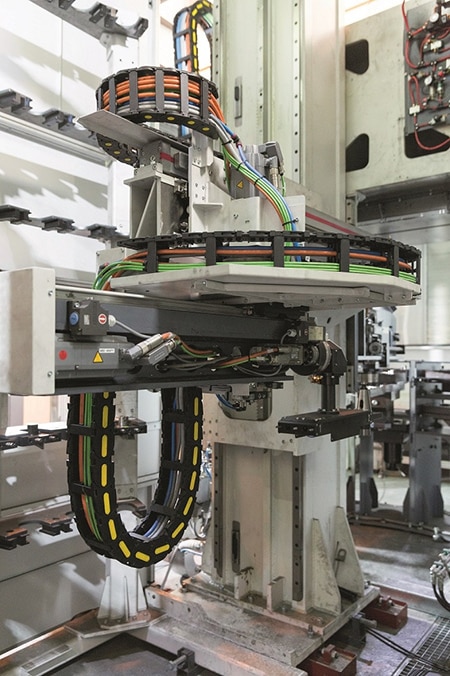了解工业应用中的柔性多芯电缆
投稿人:DigiKey 北美编辑
2025-07-01
在工业自动化、重型机械、机器人和发电等应用中,用于供电和控制的多芯电缆需要承受持续的弯曲和扭转、较大的温度变化,以及与油、水和工业化学品的接触。这些情况会导致电缆寿命缩短、操作不可靠和安全性降低。信号完整性也是一个问题,因此电缆可能需要屏蔽,以尽量减少电磁干扰 (EMI)。
这些应用系统的设计人员必须熟谙能够承受严酷工业环境的材料的特性,并了解导体布局和放置的细微差别。他们还必须确保遵守与环境能力和安全有关的国际标准。
本文首先简要介绍了工业应用的布线要求,然后介绍了 LAPP 的超柔软、连续弯曲电缆实例,并说明其材料和专用结构是如何让设计人员满足这些规格要求的。
工业运动
自动化工厂一直持续着各种各样的运动。机器人手臂伸展、旋转和收回;加工站转动和定位产品,以便进行加工和取放操作;以及机床旋转和刀头平移(图 1)。
 图 1:自动化机器需要可靠的电缆,这些电缆可以在数百万次循环中弯曲和扭曲。(图片来源:LAPP)
图 1:自动化机器需要可靠的电缆,这些电缆可以在数百万次循环中弯曲和扭曲。(图片来源:LAPP)
这些应用以及起重机、风力涡轮机和重型车辆等应用,都需要能够承受数百万次弯曲和扭转的柔性电缆。典型的电缆运动包括连续弯曲、扭转弯曲和折弯弯曲(图 2)。
 图 2:电缆面临的典型弯曲运动包括连续、扭转和折弯。(图片来源:LAPP)
图 2:电缆面临的典型弯曲运动包括连续、扭转和折弯。(图片来源:LAPP)
电缆在线性运动中来回卷动,通常是在电缆轨道中来回卷动,从而产生持续弯曲。扭转弯曲在机器人中很常见,它是由于电缆在 90° 至 360° 范围内顺时针或逆时针纵向扭转而产生的。折弯弯曲又称滴答摆动,因其与钟摆运动相似,是缆线围绕静止点来回弯曲的结果。在所有这些情况下,最高应力都出现在静止弯曲点和驱动点。
要确保电缆的可靠性和较长的功能寿命,了解如何设计电缆对应对特定类型弯曲至关重要。
柔性电缆
电缆的柔韧性取决于其内部结构。首先是有绝缘层包裹的导体。最常用的导体是铜,其次是铝和银。绝缘层可从一系列热塑性塑料或弹性体中选择,并通过挤出方式来包覆。
一般来说,用多根较细导线做成的电缆柔性较好。由于电缆的电阻是导线横截面积的函数,因此必须使用多根较细的导线来减少电缆的串联电阻。DIN VDE 0295/IEC 602258 标准规定了工业电缆的几个柔性类别(图 3)。
 图 3:针对柔性电缆结构的 DIN VDE 0295/IEC 602258 类别覆盖了用于固定应用的实心线到用于超柔性安装的超细绞合线。(图片来源:LAPP)
图 3:针对柔性电缆结构的 DIN VDE 0295/IEC 602258 类别覆盖了用于固定应用的实心线到用于超柔性安装的超细绞合线。(图片来源:LAPP)
1 类导体使用实心导线,通常由铜制成。它们旨在安装在需要固定、坚固和刚性电缆的建筑物中。
2 类导体包含多根绞合导线,每根导线的直径较小。这类电缆具有更大的柔性,但仍适用于可能需要弯曲、卷绕或偶尔移动的应用中的固定安装,例如用在最初定位和布线时。
5 类柔性导体使用更细的导线来制作具有更大柔性的电缆。这些电缆可用于便携式电动工具的线缆、延长线以及其他柔性有用但不需要反复使用的应用。
6 类超柔性导线使用超细的导线。这种导体类型适用于安装在机器人和工业机械等可移动电气设备中的电缆,以及电缆经常移动或扭曲的区域。
多芯电缆中的导线通过绞合或扭合实现圆形截面,最大限度地减小了直径,并提高了柔韧性(图 4)。
 图 4:所示为常见的电缆扭绞方式,可减少直径、确保圆形截面并提高柔性。(图片来源:LAPP)
图 4:所示为常见的电缆扭绞方式,可减少直径、确保圆形截面并提高柔性。(图片来源:LAPP)
束绞电缆包含任意数量的导线,以随机模式沿同一方向绞在一起。束状结构没有明确的几何形状,横截面可能会有变化。相关的同向绞合将具有明确的几何形状和横截面。
同心绞合电缆使用一根芯线,芯线周围是界限清楚的螺旋绞合导体层。每个同心层的绞合方向相反。由于扭曲,每条连续线路的绞合长度都会增加。同心绞合电缆用于连续弯曲应用。
同心同向导线中的导体会有一根线芯,线芯周围缠绕有一层或多层螺旋状绞合的导体。连续层数缠绕时与绞合方向相同,并且每增加一层,绞合长度就会增加。这种电缆绞合方式通常用于需要扭转和连续弯曲的设计中。
电缆结构
电缆由多根导线组成,周围包裹着多层润滑和绝缘材料。最常用的绝缘材料是聚氯乙烯 (PVC)。多根导线会绞合在一起并用保护层包裹,形成电缆。例如,LAPP ÖLFLEX FD 890 和 FD 890 CY 连续弯曲控制电缆(图 5)使用多根铜导体和特殊配方的 PVC 绝缘层。
 图 5:屏蔽和非屏蔽软电缆的结构都包括铜导体和聚氯乙烯绝缘层。(图片来源:LAPP)
图 5:屏蔽和非屏蔽软电缆的结构都包括铜导体和聚氯乙烯绝缘层。(图片来源:LAPP)
FD 890 系列电缆(图 5,上)有 3 至 50 根导线,导线规格为 20 AWG 至 2 AWG,而 FD 890 CY 系列电缆(图 5,下)则有 3 至 34 根导线,导线规格为 20 AWG 至 6 AWG。它们结构相似,只是增加了屏蔽编织层。
FD 890 CY 系列电缆包括镀锡铜编织层,适用于需要 EMI 屏蔽的应用。在工厂车间等区域,有限的空间内通常密集分布着有功功率电缆与控制电缆,因此需使用屏蔽电缆。屏蔽电缆的线芯结构与非屏蔽电缆类似,编织层下增加了一个内部 PVC 护套,使其与线芯中的导线隔离。由于多了一层,电缆直径大于同类非屏蔽电缆。外护套具有与非屏蔽电缆相同的特性。
ÖLFLEX FD 890 系列中的一个例子是 8920044 四芯非屏蔽电缆,导线规格为 20 AWG;等效公制规格为导电截面积 0.5mm2。组装后的电缆直径为 7.4 mm。屏蔽型 ÖLFLEX FD 890 CY 系列中的一个例子是 8914044S 四芯电缆,导线规格为 14 AWG。这种电缆的导电横截面积为 2.5 mm2,电缆直径为 14 mm。屏蔽编织层可覆盖芯线表面 85% 。
这两个电缆系列都超过了 6 级柔性标准。它们的额定工作电压高达 600 伏,击穿测试电压高达 2000 V。两个电缆系列的温度规格取决于应用。例如,对于需要连续弯曲的应用,温度范围为 -5°C 至 +90°C;对于固定用途,温度范围为 -25°C 至 +90°C。
最小弯曲半径是衡量电缆柔性的一个标准。它给出了电缆在不损坏的情况下所能承受的最小弯曲半径,通常用电缆直径 (D) 的倍数表示(图 6)。
 图 6:最小弯曲半径以电缆直径 (D) 的倍数来定义。(图片来源:LAPP)
图 6:最小弯曲半径以电缆直径 (D) 的倍数来定义。(图片来源:LAPP)
图 6 所示电缆的最小弯曲半径为电缆直径的三倍。FD 890 电缆的弯曲半径为 7.5 倍电缆直径。由于增加了内护套和屏蔽层,FD 890 CY 屏蔽电缆的最小弯曲半径更大,达到直径 10 倍。例如,14 mm FD 890 CY 电缆的最小弯曲半径为 140 mm。
FD 890 和 FD 890 CY 电缆通过了 UL、CSA、CE 和 RoHS 运动、阻燃、耐油和耐晒标准认证。
结语
LAPP ÖLFLEX FD 890 和 FD 890 CY 多芯电缆专为工业自动化、重型机械、机器人和发电等应用中的连续弯曲使用而设计。这些电缆使用细线绞合并使用专门配制的化合物来优化弯曲寿命,因此具有很高的耐油、耐水、耐工业冷却剂和溶剂性能。屏蔽型可用于对电磁干扰有要求的应用场合。

免责声明:各个作者和/或论坛参与者在本网站发表的观点、看法和意见不代表 DigiKey 的观点、看法和意见,也不代表 DigiKey 官方政策。






